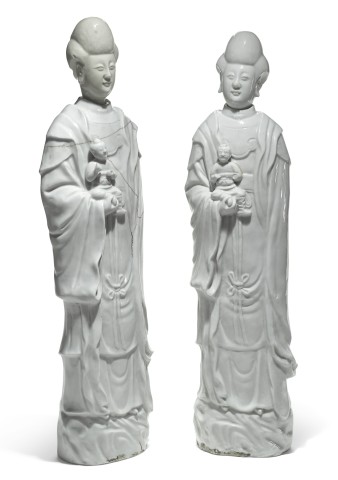The tall figures of the Bodhisattva of compassion; with calm expressions and elongated earlobes, standing on a rockwork base, wearing long, flowing robes that drape to the floor, loosely tied at the front; they each hold a small boy in their right hand, with their hair elegantly styled into a high chignon bun; from the estate of the Marquis of Lothian.
Literature
There is an almost identical pair in the collection of the English Royal family, in the Chinese Lobby at Windsor Castle (collection number is RCIN 58840). They are illustrated in John Ayers' volume 'Chinese and Japanese Works of Art in the Collection of Her Majesty The Queen, 2016, C&J pp.39-0.
Tall Dehua figures of such as these were popular among European royalty and nobility in the 17th century. Figures of this type, moulded in two parts and fired separately, are noted in the inventory (1716-18) of the Danish Royal Cabinet of Curiosities, within Rosenborg Castle (Donnelly, P. J. Blanc de Chine, Faber and Faber, pl73, 74). A similar figure is in the collection of the stately home Lyme Park, England, and another pair can be found at the Chinese Pavilion at Drottningholm, Sweden. Records show that Queen Hedrig Eleanora of Sweden purchased the pair at Drottingholm along with many other blanc-de-chine figures in the 1690's (Setterwall, A. et. al. The Chinese Pavilion at Drottingholm, inventory FE44, HGK875/876 pl.1)
These models of Guanyin are characteristic of Dehua craftsmanship in that they were constructed in two separately-fired pieces, designed to fit together. Ming dynasty figures were often hand-modelled and finished. By the Kangxi period, potters had developed moulding techniques. On the inside of these models it is sometimes possible to see the maker's finger marks from where they pushed the clay into the mould, as with the two figures of Guanyin described here.
Fujian, a tea-growing region in south-east China where the Dehua kilns were based, attracted European merchants in the 16th and 17th centuries. These merchants carried many Dehua figures back to Europe. Some figures were later decorated with strong colours, popular in Europe at the time. This was known as 'cold decoration', and often wore off as it was unfired.
As an important part of Chinese religious life and art, Guanyin was one of the most popular figures created in the Dehua kilns during the Ming (1366-1644) and early Qing (1644-1911) dynasties. She is known as the patron of mariners, and as a 'bringer of sons'. She is often depicted carrying young boys, as these are, or standing on waves with water dragons, to reflect these beliefs. In China, these figures were often placed in household altars and worshipped as devotional images, or given as auspicious gifts.

